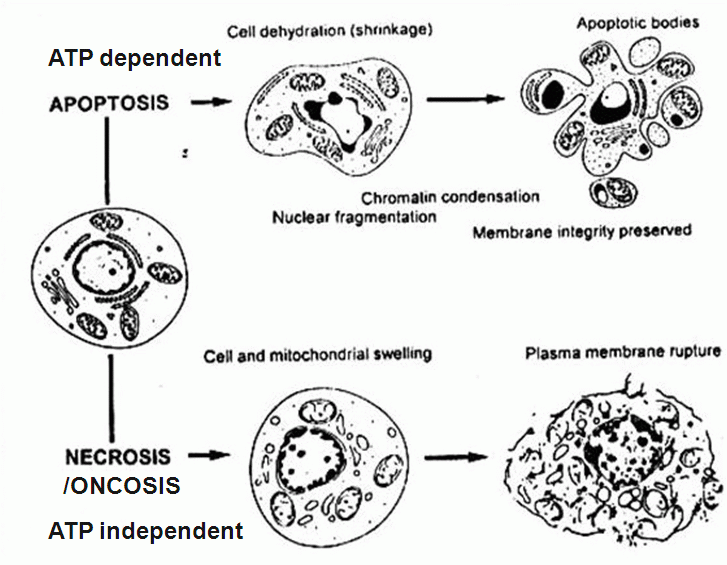Oncosis is the induction of necrosis by a nonphysiological event resulting in cell swelling as opposed to apoptosis where there is cell shrinkage, see figure below.
Oncosis can be induced by heat shock (56C or 42C), sodium azide (1% solution), Triton X-100 (0.01% solution) or drugs used to induce apoptosis at a higher concentration. Necrotic cells can be derived from the induction of apoptosis or oncosis and refers to the necrobiological events after membrane disruption. During oncosis the cell swells as does cell organelles such as mitochondria but the plasma membrane remains intact. Although it has been reported that phospholipid asymmetry is lost and the externalized phosphatidylserine can bind annexin V this is not part of the oncotic process, see figure. This is followed by the rupture of the plasma membrane during oncosis or the necrotic stage of oncosis leads to the release of proteolytic enzymes causing damage to the surrounding tissues, see figure for comparison of oncotic and apoptotic cells.
Recent research at the Blizard Institute hass shown that it is possible to immunophenotype these oncotic cells into subtypes, with dead or cell viability+ve/Caspase-3-ve cells have RIP3 or do not. These cells can be further immunophenotypes in terms of gammaH2AX and cleaved PARP expression. H2AX+ve/PARP-ve indicates cells undergoign the DNA Damage Response (DDR), while H2AX-ve/PARP+ve indicated cells undergoing caspase-3 independent apoptosis and H2AX+ve/PARP+ve with Caspase-3 indicates a hyper-activation of PARP while without indicated another form of necrosis, namely parthanatos.
Oncotic cells can be recognized by a characteristic pattern of morphological, biochemical and molecular changes, which may be broadly and chronologically defined as:
Morphological Changes- Cell swelling
- Loss of membrane integrity
- Organelle swelling
- No DNA laddering
- Free calcium ion rise
- Metabolic failure
- Loss of mitochondrial membrane potential
- Loss of plasma membrane potential
- Ion channel involvement
- Phosphatidylserine externalization
- PARP
- Proteolysis
- DNA denaturation
- Calcium regulated protein involvement
- RIP Kinase involvement
Stimulus
- Bacterial toxins
- Metabolic poisons
- Ischemia
- Stroke
- Calcium overload
- Heat shock
Many of these changes may be measured by flow cytometry and some are described below.
Publication.
G Warnes, S Martins. Real-time flow cytometry for the kinetic analysis of oncosis. Cytometry 79A, 181-191, 2011.
A Tarnok. Review of Real-time flow cytometry for the kinetic analysis of oncosis. Cytometry 79A, 177-178, 2011.
A Vossenkamper, G Warnes. Flow cytometry reveals the nature of oncotic cells, Int. J. Mol. Sci. 20(18), 4379; 2019.

